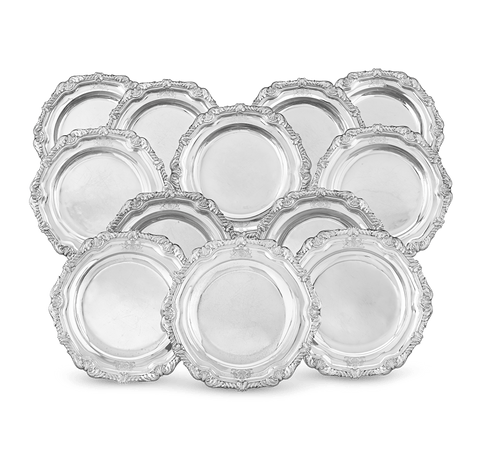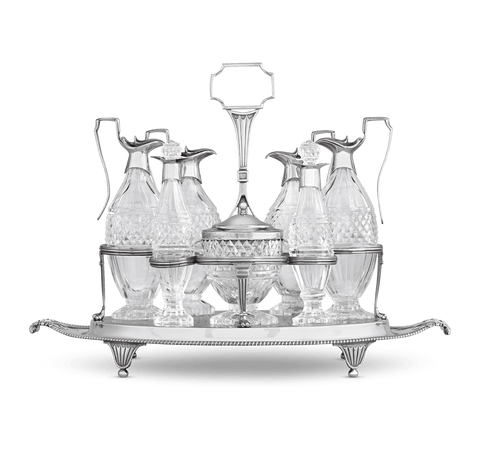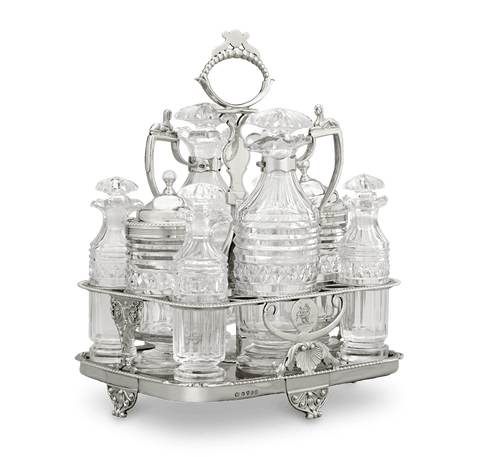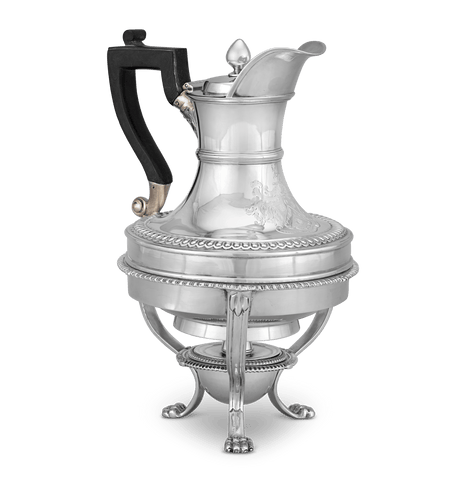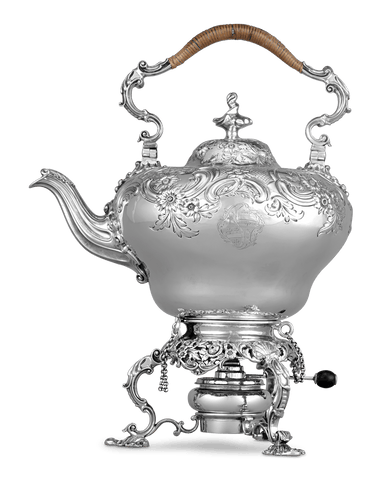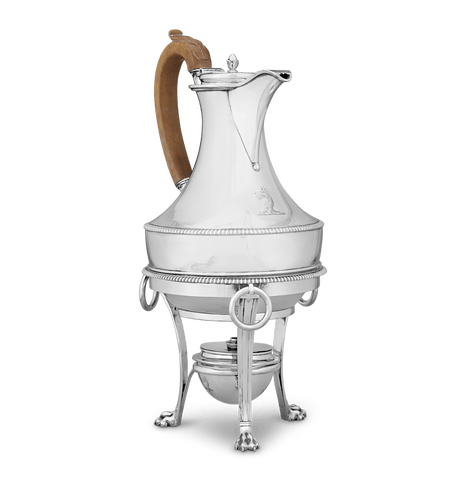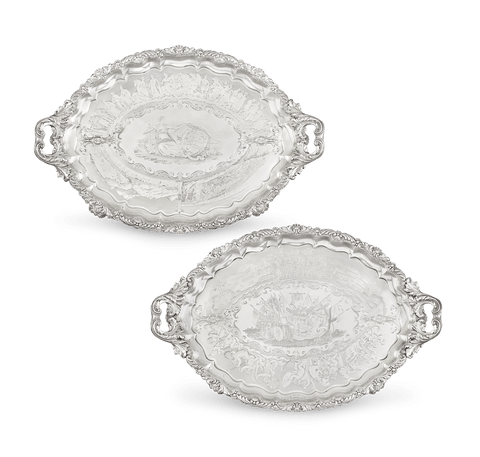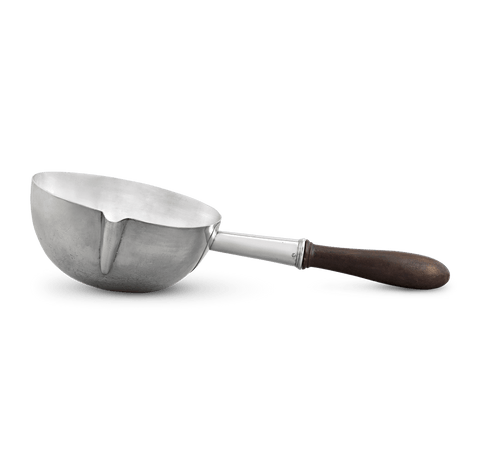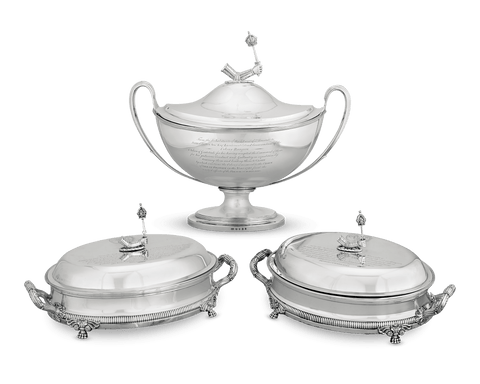Artists & Artisans
Storr, Paul
(1752-1817)
Paul Storr is hailed as one of the most exceptional silversmiths in history, renowned for his mastery in perfecting the styles and designs of the Regency period. From his awe-inspiring Neoclassical masterpieces to his lavishly adorned and exuberant Rococo vessels, Storr imbued his creations with an unparalleled level of craftsmanship and superior quality that remains unmatched to this day.
Education & Early Career
Born in 1771 in London, Paul Storr entered the world during a period of rapid industrial and cultural advancement. By the turn of the century, London had not only become Europe's largest city but also a bustling hub of commerce. Recognizing the potential for prosperity, Storr's father, a silver chaser, saw goldsmithing as a lucrative career path for his son. At the tender age of fourteen, Storr embarked on an apprenticeship under the tutelage of Swedish goldsmith Andrew Fogelberg.
Under Fogelberg's guidance, Storr immersed himself in the neoclassical style, which had gained widespread popularity in the late 18th-century decorative arts. Demonstrating exceptional talent, Storr's career progressed swiftly. After completing his apprenticeship, he formed a partnership with established plate worker William Frisbee. Collaborating with Frisbee, Storr crafted intricately detailed silver pieces that showcased classical motifs, laying the foundation for his burgeoning reputation.
However, the Storr-Frisbee partnership was short-lived. Driven by his desire to establish himself in West London, Storr made a pivotal decision.
In 1796, he inaugurated his own shop on Air Street, where he refined his signature style characterized by elegant simplicity within the neoclassical aesthetic. Notably, in 1799, Storr crafted the illustrious Battle of the Nile Cup, also known as the Turkey Cup, as a tribute to Lord Horatio Nelson's triumph over the French Revolutionary Navy off the coast of Egypt's Nile Delta. Two years later, Storr married Elizabeth Susanna Beyer, whose family hailed from a lineage of piano and organ makers. Together, they raised a family of ten children.
Rundell, Bridge and Rundell and the Rococo
In 1806, Paul Storr commenced his work for the prestigious firm of Rundell, Bridge and Rundell, renowned as the foremost silver retailer of the early 19th century. Unparalleled in their output, the firm specialized in crafting an array of opulent objects and luxury goods, including silverware, jewelry, medals and snuff boxes. Garnering the Royal Warrant in 1806, they created countless treasures in gold and silver for royalty, with a particular focus on fulfilling the lavish tastes of Prince Regent George IV, who favored the exuberant Rococo decorative style. The public eagerly followed suit, embracing the same preferences.
Phillip Rundell, a savvy entrepreneur, recognized that his success depended on aligning with prevailing fashion trends and harnessing the talent of exceptional craftsmen. He acknowledged Storr's exceptional skills and proposed a partnership in 1803. However, it wasn't until 1806 that Storr finally agreed, under the condition that his workshop would be known as "Storr & Co.," and that he would retain the freedom to pursue his own commissions. Demonstrating immense trust, Rundell not only accepted these terms but also allowed Storr to use his personal hallmark.
Immersed in a flood of work from Rundell, Storr adeptly adapted his neoclassical aesthetic to the bold Rococo forms favored by Rundell's affluent clientele. Despite achieving significant success and recognition, Storr eventually grew dissatisfied. He has begun to feel more like a supervisor overseeing projects rather than a master craftsman. Sensing a loss of individuality and artistic integrity, he made the decision to part ways with the firm in 1819.
Storr and Mortimer: Natural Forms
During his time with Rundell, Bridge and Rundell, Storr had adapted his style and began crafting more asymmetrical pieces with natural motifs in the Rococo style. His departure meant that his style would change yet again, and he began to explore more naturalistic forms. Eventually, he joined forces with John Mortimer, who handled the retail side of the business while Storr continued as a craftsman. Unfortunately, Mortimer proved not only difficult to work with but also ineffectual. He almost bankrupted their operation until John Samuel Hunt joined as a partner, bringing new capital.Last Years and Legacy
During this tumultuous time, Storr tried to convince his son, Francis, to join the trade. Francis was reluctant, as he wished to continue his education at Oxford University and potentially join holy orders. But, at the behest of his father, he agreed and became an apprentice on April 17, 1828. This, however, didn’t last. Shortly after Francis left the firm, Storr retired from silversmithing in 1838 and passed away on March 18, 1844. His final resting place is in the Churchyard of St. Nicholas in Tooting, England. Storr is commemorated by a memorial erected in his honor at the Church of St. Mary in Otley, Suffolk.The enduring legacy of Paul Storr lives on through his world-renowned works in silver and gold. His extraordinary creations continue to captivate admirers, displayed in galleries, museums and private residences across the globe. Even today, Paul Storr is revered as one of the greatest silversmiths in history.
Artists & Artisans
Storr, Paul
(1752-1817)
Paul Storr is hailed as one of the most exceptional silversmiths in history, renowned for his mastery in perfecting the styles and designs of the Regency period. From his awe-inspiring Neoclassical masterpieces to his lavishly adorned and exuberant Rococo vessels, Storr imbued his creations with an unparalleled level of craftsmanship and superior quality that remains unmatched to this day.
Education & Early Career
Born in 1771 in London, Paul Storr entered the world during a period of rapid industrial and cultural advancement. By the turn of the century, London had not only become Europe's largest city but also a bustling hub of commerce. Recognizing the potential for prosperity, Storr's father, a silver chaser, saw goldsmithing as a lucrative career path for his son. At the tender age of fourteen, Storr embarked on an apprenticeship under the tutelage of Swedish goldsmith Andrew Fogelberg.
Under Fogelberg's guidance, Storr immersed himself in the neoclassical style, which had gained widespread popularity in the late 18th-century decorative arts. Demonstrating exceptional talent, Storr's career progressed swiftly. After completing his apprenticeship, he formed a partnership with established plate worker William Frisbee. Collaborating with Frisbee, Storr crafted intricately detailed silver pieces that showcased classical motifs, laying the foundation for his burgeoning reputation.
However, the Storr-Frisbee partnership was short-lived. Driven by his desire to establish himself in West London, Storr made a pivotal decision.
In 1796, he inaugurated his own shop on Air Street, where he refined his signature style characterized by elegant simplicity within the neoclassical aesthetic. Notably, in 1799, Storr crafted the illustrious Battle of the Nile Cup, also known as the Turkey Cup, as a tribute to Lord Horatio Nelson's triumph over the French Revolutionary Navy off the coast of Egypt's Nile Delta. Two years later, Storr married Elizabeth Susanna Beyer, whose family hailed from a lineage of piano and organ makers. Together, they raised a family of ten children.
Rundell, Bridge and Rundell and the Rococo
In 1806, Paul Storr commenced his work for the prestigious firm of Rundell, Bridge and Rundell, renowned as the foremost silver retailer of the early 19th century. Unparalleled in their output, the firm specialized in crafting an array of opulent objects and luxury goods, including silverware, jewelry, medals and snuff boxes. Garnering the Royal Warrant in 1806, they created countless treasures in gold and silver for royalty, with a particular focus on fulfilling the lavish tastes of Prince Regent George IV, who favored the exuberant Rococo decorative style. The public eagerly followed suit, embracing the same preferences.
Phillip Rundell, a savvy entrepreneur, recognized that his success depended on aligning with prevailing fashion trends and harnessing the talent of exceptional craftsmen. He acknowledged Storr's exceptional skills and proposed a partnership in 1803. However, it wasn't until 1806 that Storr finally agreed, under the condition that his workshop would be known as "Storr & Co.," and that he would retain the freedom to pursue his own commissions. Demonstrating immense trust, Rundell not only accepted these terms but also allowed Storr to use his personal hallmark.
Immersed in a flood of work from Rundell, Storr adeptly adapted his neoclassical aesthetic to the bold Rococo forms favored by Rundell's affluent clientele. Despite achieving significant success and recognition, Storr eventually grew dissatisfied. He has begun to feel more like a supervisor overseeing projects rather than a master craftsman. Sensing a loss of individuality and artistic integrity, he made the decision to part ways with the firm in 1819.
Storr and Mortimer: Natural Forms
During his time with Rundell, Bridge and Rundell, Storr had adapted his style and began crafting more asymmetrical pieces with natural motifs in the Rococo style. His departure meant that his style would change yet again, and he began to explore more naturalistic forms. Eventually, he joined forces with John Mortimer, who handled the retail side of the business while Storr continued as a craftsman. Unfortunately, Mortimer proved not only difficult to work with but also ineffectual. He almost bankrupted their operation until John Samuel Hunt joined as a partner, bringing new capital.Last Years and Legacy
During this tumultuous time, Storr tried to convince his son, Francis, to join the trade. Francis was reluctant, as he wished to continue his education at Oxford University and potentially join holy orders. But, at the behest of his father, he agreed and became an apprentice on April 17, 1828. This, however, didn’t last. Shortly after Francis left the firm, Storr retired from silversmithing in 1838 and passed away on March 18, 1844. His final resting place is in the Churchyard of St. Nicholas in Tooting, England. Storr is commemorated by a memorial erected in his honor at the Church of St. Mary in Otley, Suffolk.The enduring legacy of Paul Storr lives on through his world-renowned works in silver and gold. His extraordinary creations continue to captivate admirers, displayed in galleries, museums and private residences across the globe. Even today, Paul Storr is revered as one of the greatest silversmiths in history.
